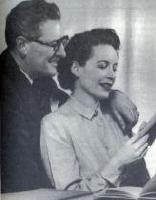Peter Murray Hill

Peter Auriol Murray Hill, who served as ABA president in 1956-1957, was born on 20th April 1908 at Bushey in Hertfordshire, the son of George Murray Hill, a solicitor, and his second wife Ida Stogdon, who had married in 1907.
Tall, handsome and charming, his first career was on the stage, coming to some prominence in the 1930s, although already selling books between performances. He appeared in a dozen or more films between 1938 and 1945, including The Outsider (1939), with George Sanders; The Ghost Train (1941), with Arthur Askey; a leading rôle in Mr. Reeder in Room 13 (1941), based on an Edgar Wallace story; another leading rôle in Rhythm Serenade (1943), opposite Vera Lynn, and Bell-Bottom George (1944), with George Formby.

In 1941 he married Phyllis Hannah Bickle at Chelsea – the couple had met while acting in Max Catto’s Punch without Judy at the Q Theatre. His wife was of course better known as Phyllis Calvert (1915-2002), then becoming one of the really major stars of British stage and screen, remembered in particular for her portrayal of Patricia Graham in the original stage production of Terence Rattigan’s Flare Path (1942) and for the starring rôle in the film adaptation of Michael Sadleir’s Fanny by Gaslight (1945), with James Mason and Stewart Granger. Two further films in 1945, both hugely successful at the box-office, and both of which also starred Peter Murray Hill, were They Were Sisters, with James Mason again and based on a Dorothy Whipple novel, and Madonna of the Seven Moons (1945), among the most exotic of all the Gainsborough Studios melodramas – this time with Stewart Granger and Patricia Roc. Her final film appearance saw her emerge from retirement to feature as Aunt Helena in Mrs Dalloway (1997), starring Vanessa Redgrave and Michael Kitchen.
Save a memorable Captain Hook on the London stage, opposite his wife as Peter Pan, Peter Murray Hill himself, aside from his war-work as Police Force Reservist, was now concentrating on bookselling, issuing catalogues from at least as early as 1941, specialising in eighteenth-century books and rapidly becoming a leading figure in the rare book world.
His introduction to the presidency of the ABA was overshadowed by the furore surrounding the auction-ring which had carved up the Lowther Castle library in late 1955. The ABA was attacked in the House of Commons and publicly humiliated in the press. The Times led off with a Saturday leader headed “This Shabby Business” and, following a reply from the ABA, followed up with “Only a Little Crooked”. The second leader began, “For a body concerned with the written word the Antiquarian Booksellers’ Association is singularly inept in its public statements”.
The situation was salvaged by a group of members, headed by Peter Murray Hill’s good friend and fellow non-ringer Percy Muir (himself a former president), calling an Extraordinary General Meeting which condemned the “totally inadequate” actions of the ABA Committee and demanding changes to rules and attitudes – these to be implemented in short order. An amendment expressing confidence in the ABA Committee mustered just four votes. A further general meeting three weeks later conceded all the salient points – the rules were changed and both existing and prospective members were required to sign a document opposing the activities of auction-rings (an undertaking still asked for although now absorbed into a much wider Code of Practice). The Times was pleased to report that “thanks to the determined pressure of men of good will, who form an overwhelming majority of the antiquarian bookselling profession, the minority of cave dwellers has suffered defeat”.
With days to spare, the way had been cleared for the ABA to welcome the International League of Antiquarian Booksellers to the London Conference of 1956 with a clear conscience. Over 160 participants from overseas – and they were delighted with what they found. The Austrian association’s newsletter reported, “There are few more pleasant places in which to do business than the English book trade … London is the place where the greatest supply is to be found. So every foreign visitor found a richly laid table …”.
Here Peter Murray Hill was in his element. An opening cocktail party on Park Lane. A reception at Sotheby’s (with an exhibition of stock from the provincial members of the ABA – precursor of the book-fair). Swan Lake at Covent Garden (with a cold buffet in the famous crush-bar to follow). An excursion on a Thames steamer to Greenwich, with a visit to the National Maritime Museum and the Caird Collection. A buffet lunch in a marquee in Greenwich Park. A farewell dinner for more than 350 at the Savoy Hotel.
“Mr. Murray Hill, who greeted each guest, wore a red ribbon, the insignia of the President of the ABA. At his side stood his charming little daughter, representing her mother, Miss Phyllis Calvert, the actress, who could not be present until later”. A witty speech from Murray Hill. The presentation to the ABA of “something useful for its office” – a gavel from Asprey’s. Perhaps less witty speeches from all of the other presidents. Then the cabaret – Mozart and Strauss arias; a clairvoyant (?); two acrobatic dancers and a cabaret singer – the whole presented by a well-known TV announcer. Dancing to the band until 2am. Those were the days.
A resounding success – and a personal triumph. A little over a year later, Peter Murray Hill died at the age of just forty-nine on 25th November 1957.
Laurence Worms, February 2013.
